Creating Gaps
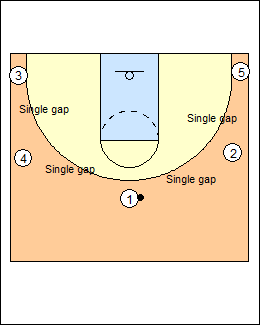 | 1 This outline complements Blog Posts on 5-Out Motion, 5-Out Dribble Attack, and Dribble-Drive Motion. 1) 5-out spacing 3) Two-guard 5-out spacing A goal on offence is to create gaps for dribble penetration. Gaps are created by spacing and cutting, other players hold their spacing to maintain a gap, then fill spots or react to a drive. 1) 5-out spacing Conventional 5-out spacing uses three guards. There are single gaps between all attackers, defenders can help and recover on dribble penetration. Cuts are needed to create bigger gaps. Mike MacKay - Single-Double Gaps - the problem with single gaps is stationary passes and quick help and recovery. Create a double gap by cutting a player. Gap Theory (Spacing) - 5-out spacing (50) stretches the defence outside the paint and takes away a traditional rim protector. Learn the Gap Theory - the foundation is great spacing, try to create mismatches, make 2 guard 1, and win closeouts (shoot while the defender is still closing out, or drive if the closeout is too aggressive). Coach Daniel - Future of Offence - on a drive from the top with 5-out spacing, the help is late. Having 4 guys out and one guy in the dunker spot is still 5-out spacing to him. Tyler Coston - Race and Space Overview - keep the rim open as much as possible, hunt that space with the dribble, he doesn't want players cutting to the rim all the time. See Offences - 5-out youth motion, MacKay single-double gaps. |
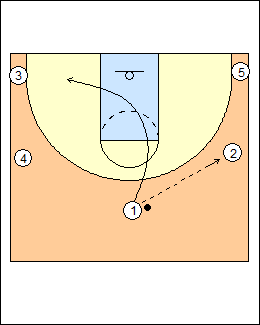 | 2 a) Here 1 creates space by passing and cutting, and 4 holds for a two-count to maintain the gap. 2014 San Antonio Spurs - basic philosophy of ball movement (passing) and player movement (cutting). They played “point 5 basketball” – after catching the ball, make a decision to pass, shoot or drive within half a second (Steph Curry - that’s when the dominoes start to fall). Goals on offence are to create an advantage and convert it into a basket (advantage basketball). The Spurs used ballscreens to create advantages, and converted by attacking close-outs off the dribble (using pump fakes) and with relocation cuts on dribble penetration (drive, kick, exit). |
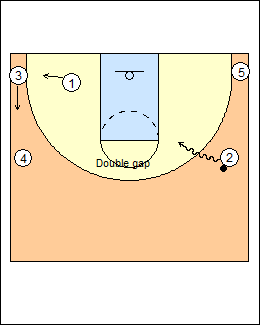 | 3 2 has a double gap to attack middle. How 4 reacts depends on the offence, e.g. backcut or rotate behind. |
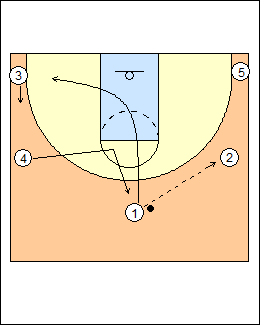 | 4 If 4 immediately fills behind when 1 passes and cuts, there is no double gap. |
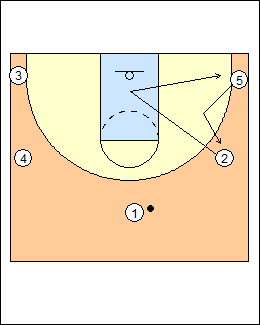 | 5 b) Here 2 creates space with a back cut, exit cuts to the corner, 5 fills behind and takes away the space. Adam Spinella - Hoiberg 5-Out Concepts - 5-out spacing allows for backcuts, the rim is vacated. 5-Out Revolution - with 5 at the top of the key with the ball and the paint wide open, basket cuts are especially effective. Alex Sarama - Building a Conceptual Offence - 5-out spacing is quicker to get into than 4-out 1-in, you won't have to wait for a trailer to get down to the low post. In a neutral situation, they immediately run a trigger to get double-gap spacing, e.g., the trailer screens away or drag screens, they are not in 5-out for long. |
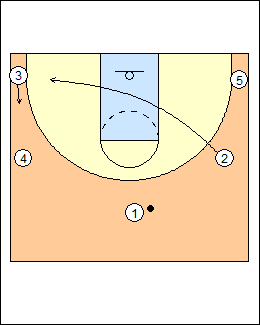 | 6 If 2 backcuts and clears weakside, 5 can hold in the corner. See Offence - 5-out dribble attack continuity. Gregg Popovich - if denied anywhere on the court, go backdoor and continue in the direction you were going. Chris Krauss - Motion Concepts - he doesn't like cuts all the way through, cut to the middle, read what's going on, you might have to come back, or relocate. |
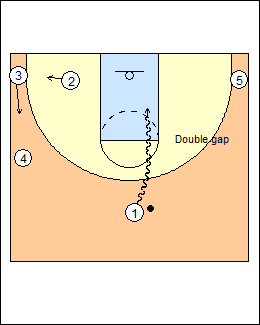 | 7 5 holds, 1 has a double gap to attack. |
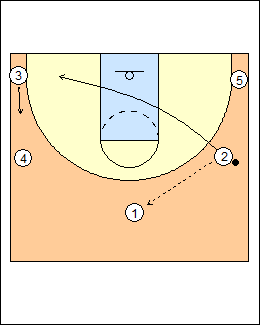 | 8 c) Use the same approach on a pass out top from a wing, cut and clear to the other side, instead of exiting out to the corner on the same side. |
 | 2) 4-out 1-in spacing 4-out 1-in automatically creates some additional space on the perimeter. Gap Theory (Spacing) - spacing creates gaps to attack, 4-out 1-in spacing (41) is most common as it maximizes space for each gap. Coach Daniel - Future of Offence - having 4 guys out and one guy in the dunker spot is still 5-out spacing to him. a) A three-guard front allows full ball reversal with two passes, and can be used with a low post and one corner player (see Fast breaks - Mike Brown early flow). There are still single gaps, but 2 has space to drive baseline. |
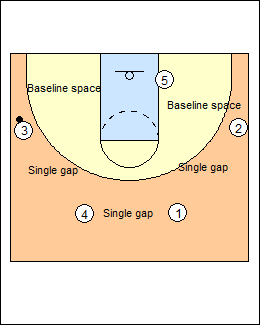 | 10 b) With two guards and two wings, there are single gaps but 3 and 2 have space to drive baseline. KG Basketball - 5-Out DDM - initial 5-out spacing has small gaps (defences turn into almost a 1-2-2 zone), and he still wants a rim runner, so he uses a 4-out 1-in entry to get into 5-out. Spinella - Hoiberg 5-Out Concepts - from 4-out 1-in, 5 can gut cut out top for a pass (then with a 45 cut from the weakside wing). Check-List for Your Team Offence - ball reversal can be achieved through stepping interior players to the perimeter. |
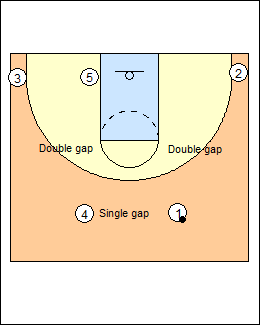 | 11 c) 2 and 3 move down to the corners, creating double gaps, making it harder for defenders to help and recover. There is still a single gap up top. See Offence - Dribble-drive outline. |
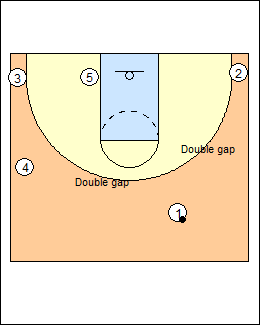 | 12 d) If 4 spaces away high and wide, 1 has two double gaps. See Blog Posts - Two-Side Fast Break, Fast-Break Cycles, Fast breaks - Two-side (Rocket). |
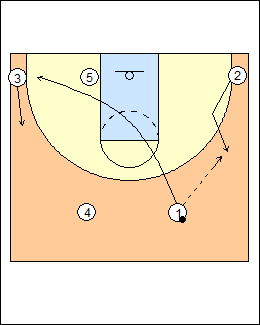 | 13 e) 2 blast cuts for a guard-to-wing "quick" pass from 1, who clears to the opposite corner. |
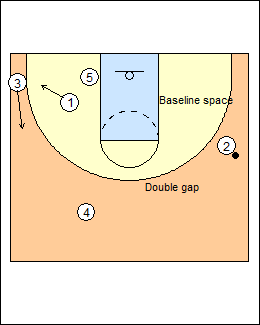 | 14 2 has a double gap to attack middle, and space to drive baseline, a wing isolation. How to Teach Youth Motion - automatic drives are a) draft drives (follow a cutter), b) real-estate drives (the spot next to you is empty), c) your defender steps over the 3-point line. |
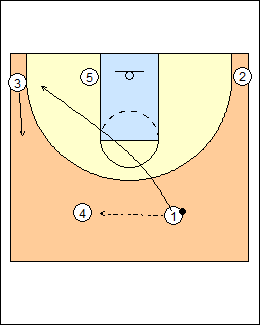 | 15 f) On a guard-to-guard "swing" pass, 1 corner cuts to change sides of the floor and create a triple gap for 4. |
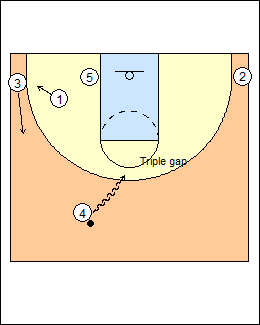 | 16 2 holds in the corner. |
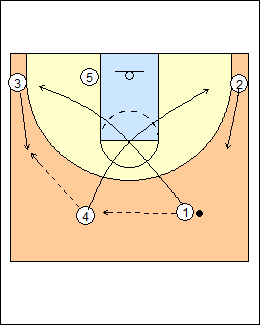 | 17 g) 1 makes a "swing" pass to 4 and corner cuts, 4 makes a "quick" pass to 3 and clears weakside. The passing combination is "swing-quick". See Tactics - Dribble-drive quick-swing (Swing-quick). |
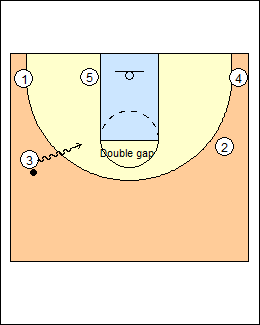 | 18 3 has a double gap to attack middle. |
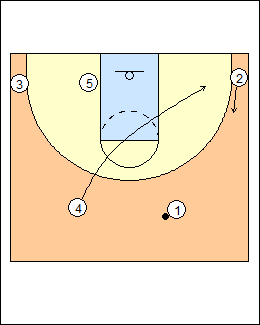 | 19 h) To create space for ballhandler 1, 4 corner cuts. |
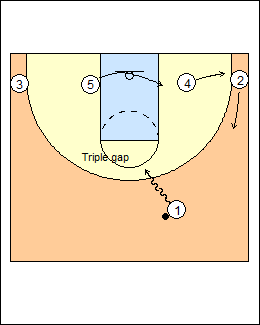 | 20 |
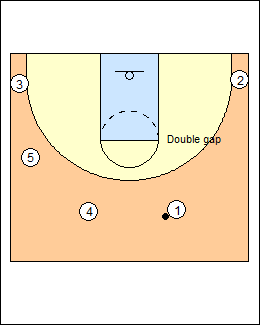 | 3) Two-guard 5-out spacing 5-out spacing can be done with two slots, two corners, and a weakside or ballside wing player. See Offence - 5-out dribble-drive motion, Tyler Lyndsey 5-out Drive and Space (YouTube) and Screenshots. Here wing 5 is weakside, 1 has one double gap. |
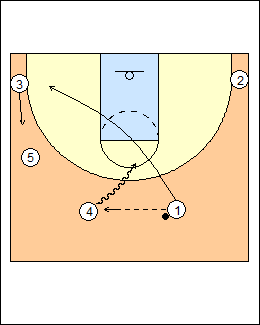 | 22 1 can create a triple gap for 4 with a swing pass and corner cut. 4 could finish the swing with a "quick" pass to 5 and clear weakside (swing-quick). |
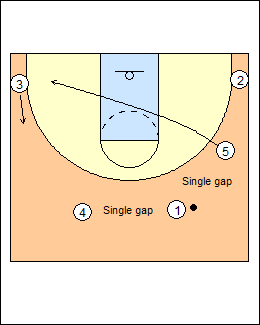 | 23 |
This page was made with Basketball playbook from Jes-Soft
